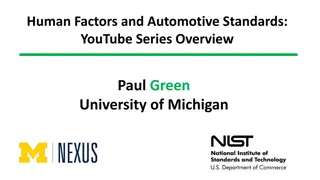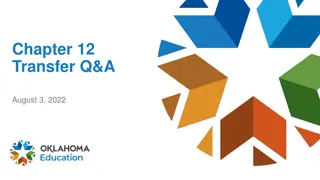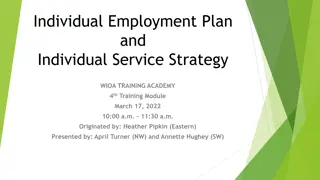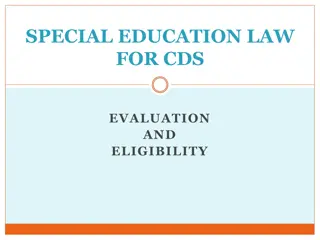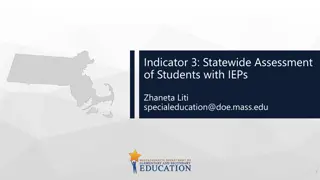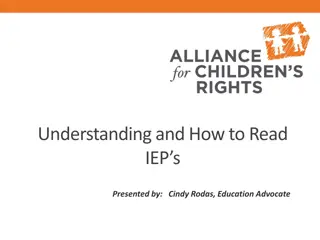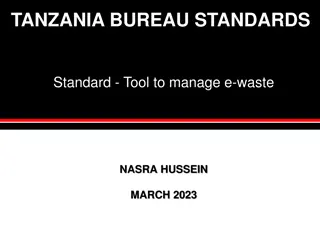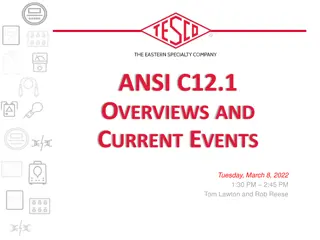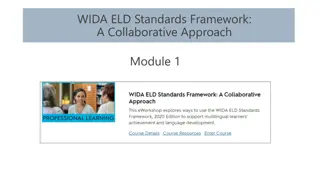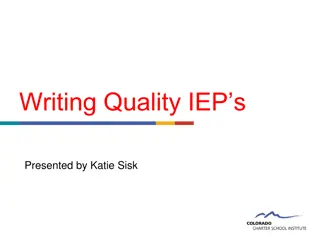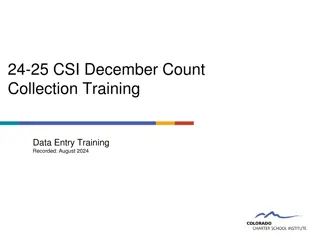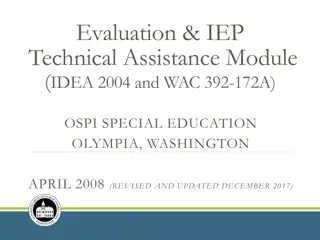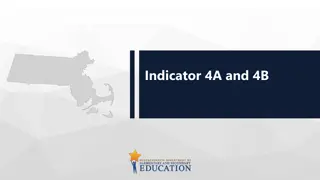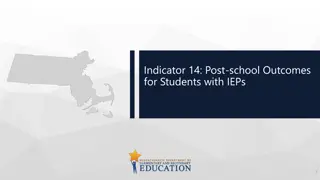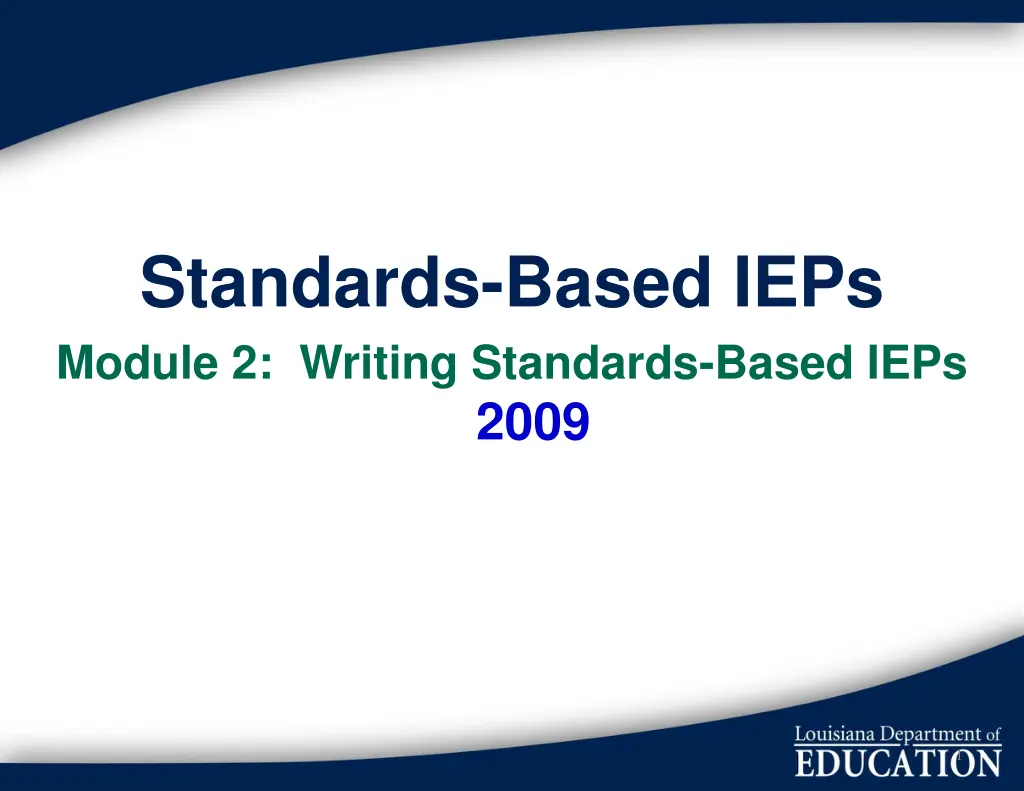
Writing Effective Standards-Based IEPs
Learn how to write standards-based IEPs to support student progress in the general education curriculum. Understand the background for standards-based reform, educational planning, and developing effective IEPs that focus on individual student needs, accessibility to the curriculum, and alignment with state assessments.
Download Presentation

Please find below an Image/Link to download the presentation.
The content on the website is provided AS IS for your information and personal use only. It may not be sold, licensed, or shared on other websites without obtaining consent from the author. If you encounter any issues during the download, it is possible that the publisher has removed the file from their server.
You are allowed to download the files provided on this website for personal or commercial use, subject to the condition that they are used lawfully. All files are the property of their respective owners.
The content on the website is provided AS IS for your information and personal use only. It may not be sold, licensed, or shared on other websites without obtaining consent from the author.
E N D
Presentation Transcript
Standards-Based IEPs Module 2: Writing Standards-Based IEPs 2009 1
Background for Standards-Based Reform IDEA 1997 Involved in and progress in the general education curriculum No Child Left Behind Act of 2001 Aligned system of standards and assessments Accountability for all students (disaggregated by subgroup) State and local Adequate Yearly Progress IDEA 2004 Reinforces NCLB language and accountability Reinforces IDEA language for the student to be involved in and make progress in the general education curriculum 3
Standards-Based Educational Planning The development of appropriate goals for the IEP The goals should not be based on the content standards because they are too broad The goal is to address the gap between the standard and the student s functioning level The student s needs that result from the disability (specific skills based on the student s disability) 300.320 How the child s disability affects the child s involvement and progress in the general education curriculum (i.e., the same curriculum as for non-disabled children). 4
Developing Standards-Based IEPs Access to the general education curriculum means teacher-created opportunities to learn important content reflected in the content standards The IEP is the cornerstone of access to the general education curriculum for students with disabilities If a need is described on the GSI, then a measurable annual goal must be written to address each need 5
The IEP: What it should be! Tool to support alignment of classroom instruction to the student s needs and the state assessment Individualized - Address needs which results from a child s disability Inclusive of needs which occur outside of the general curriculum (e.g., social and behavioral skills) It is a working document that guides the instructional team 6
The IEP: What it is not! Is not a separate curriculum Should not be a reiteration of what already exists in the Benchmarks, GLEs, and/or Extended Standards Does not address all content/skills that the students will need to learn across the school year NOT merely a compliance document 7
How does this new approach change the IEP? Provides greater alignment for students with disabilities between instruction and the contentthat are the state s standards Provides meaningful opportunities for students with disabilities to truly be involved in accessing and making progress in the general education curriculum 8
What are standards-based goals? Discussion of the student s present performances begins with the standards the student has already achieved that will allow the student to work toward grade-level standards. Standard-based goals focus on bridging the gap from where the student is to where the student needs to be relative to the standards reflectthe student s need for key academic skills to access the standard providemore specificity about the student s involvement and participation in the general education curriculum 9
What are some advantages to standards -based IEPs? More meaningful access for students with disabilities Higher expectations for students with disabilities Allows general education teachers and special education teachers to work together in more collaborative ways Promote IEPs that allow general education teachers and special education teachers to speak the same language (i.e., the language of standards) Better prepares students for state assessments 10
How do standards-based IEPs affect students performance on statewide assessment? By ensuring alignment among: Instruction Assessment Content 11
Documents that will assist teachers in educational planning as students work toward grade-level standards Louisiana s Content Standards and Benchmarks Louisiana s Grade-level Expectations (GLEs) Louisiana s Extended Standards For students with significant disabilities Louisiana s Comprehensive Curriculum Activities Access Guide 12
If educational research can tell us anything, it is that students are more likely to learn something at school if it is taught than if it is not. Walter C. Parker (1991). Renewing the Social Studies Curriculum. 13
Writing Standards-Based IEP A TEAM EFFORT 14
What steps do IEP Teams need to follow to develop effective standards-based IEPs? Step 1:Know content standards/GLEs (and Extended Standards) for the student s grade Step 2: Gather data Step 3:Determinethe student s performance level Step 4:Develop measurable annual goals Step 5:Perform routine progress monitoring Step 6:Identify supports Step 7:Determine type of statewide assessment 15
Step 1: Know the Content Standards & GLEs (and Extended Standards, as needed) for student s grade Content Standards, benchmarks and GLEs for the student s enrolled grade (and, as needed, Extended Standards for the grade span in which the student is enrolled) Be very familiar with the GLEs across a range of grades Student is likely performing several grade levels below 16
State Assessment Interpretative Guides LEAP/GEE http://www.louisianaschools.net/lde/uploads/1278.pdf iLEAP http://www.louisianaschools.net/lde/uploads/9725.pdf LAA 2 http://www.louisianaschools.net/lde/uploads/9731.pdf LAA 1 http://www.louisianaschools.net/lde/uploads/7522.pdf 17
Find the Answers to these Questions: What is the intent of the content standard? What should the student know and be able to do? Has the student been taught content aligned with the grade- level standards and/or Extended Standards? Has the student been provided appropriate instructional scaffolding to attain grade-level expectations or Extended Standards? Does the student have an appropriate/adequate means to express what he or she knows relative to the content standard? Were the lessons and teaching materials used to teach the student aligned with state grade-level standards/Extended Standards? Was the instruction evidenced-based? Were researched-based materials, strategies, supports used? Was assistive technology considered? For a student with print disabilities: Was the student provided core and supplemental materials in an accessible format? (AIM) 18
Step 2: Gather data Multiples sources State assessments (Student Reports [SR]) Curriculum-based assessments (pre/post tests) Formative and summative assessments Student work samples of student s writing, application type skills Previous year s IEP Other information (e.g., grades, discipline referrals, attendance reports, health info, AT Assessments) 19
Meet Annie 20
Meet Lilly 21
General Student Information Non-example Non-example but better XXX is a senior at XXX High School. He is scheduled to exit on May 8, 2008 XXX is a fourth grader at XXX Elementary. XXX is repeating 4th grade due to unsatisfactory ELA scores on LEAP. Decoding and comprehension skills are weak. XXX is polite and has good attendance. 22
Activity Write the GSI Utilizing steps 1 and 2 (Tell me what s in the steps) In your group, examine the data for the case study student What data are important? What does the data show regarding the knowledge and skills the student has demonstrated in relation to the GLEs and/or Extended Standards? Did you find any discrepancies in the case study provided? 23
GSI components of General information about the student Strengths what is the student able to do Parent concerns Evaluation/reevaluation results Academic, developmental and functional needs- what does the student need assistance with? Statewide assessment results Progress or lack of expected progress in the general education curriculum Consideration of special factors Behavior Use of Braille Assistive Technology Limited English Proficient Communication Needs Health Needs 24
Why Assistive Technology? IDEA mandates that we consider AT for EVERY student IDEA defines AT IDEA supports Universal Design IDEA requires that LEAs ensure Accessible Instructional Materials (AIM) any item, piece of equipment, or product system, whether acquired commercially or off the shelf, modified, or customized, that is used to increase, maintain, or improve functional capabilities of individuals with disabilities
Making Good Decisions SETT Framework S - The student s skills or issues of access affecting performance E - The environment(s) where the completes task T - The task(s) that the student needs to accomplish T - Other strategies, modifications or accommodations (technology or non- technology strategies) http://www.louisianaschools.net/lde/eia/1538.html (Zabala,1999)
Step 3: Determine the students performance level To provide a summary of baseline information that indicates the student s academic achievement To identify current functional performance To provide an explanation of how the disability affects the student s involvement/progress in participating in the general education curriculum, for preschool children, as appropriate, to participate in age-appropriate activities 27
Purpose of writing the academic achievement and functional performance statements The present level of performance answers the questions: What is the student able to do NOW ? What is the student NOT able to do? 28
Present Level of Performance Remember The present level of academic achievement and functional performance sets the stage for developing IEP goals and objectives! 29
Things to consider Separate present levels of performance should be developed for the individual academic/ social/behavior/functional areas for which there is a concern (math and ELA should not be combined) There is no need to write goals for every content area Difficulties in the area of Science, Social Studies are more likely related to reading or mathematics than a disability in a content area Unless the student has a specific study skills need, a goals should not be written because that is the class/course the student is in. (high school) 30
Annies Present Level of Performance Annie is functioning below grade level in reading according to the DIBELS screening and the CBM. Her reading fluency rate is 68 minutes per minute with 65% accuracy. She is reading on a late 2nd grade level according to the DIBELS benchmarks. Annie s below level reading fluency limits her reading comprehension. 31
Present Level of Performance Non-example but better Non-example Student has been performing satisfactory in all academic classes. Student has not been a behavior problem and hopefully it will remain that way. Scaled score on the spring, 2006 GEE ELA was 251. Student has earned 14 Carnegie units. Student has no literacy skills. Student has mastered A- 1-A-7 & A10. He is missing the final criteria point on A8-10 Student is working on linear equations in Alg. 1, Part 1, presenting a report on Romeo and Juliet in English, and learning about China in Geography. Her weaknesses are in reading comprehension, nouns, pronouns, verbs, and concepts, estimation, data interpretation and algebra. 32
Activity write the present level of academic achievement and functional needs For each educational need area indentified in the GSI using the data collected Student work Formative/summative data Statewide assessment data Curriculum based assessment data Observational/behavioral data 33 33
Step 4: Develop Measurable Annual Goals based on standards Purpose To describe what a student can accomplish in one school year Annual Goals answer the question - What should the student be doing? Focus Address the students disability which interferes with learning and educational performance Level the playing ground minimized the area of need so that the disability does not hinder the student s ability to perform/function in daily life 34
Measurable Annual Goals Academic goals are developed from The student s needs that result from the student s disability to enable the student to be involved in and make progress in the general education curriculum based on the gap between the present levels of academic performance and : Louisiana content standards or Louisiana Grade Level Expectations or Louisiana Extended Standards (for students with significant cognitive disabilities) 35
For students with significant disabilities consider both: Specific Academic Goals - directly aligned to grade-level academic content Is it really reading? Is it really math? Is it aligned to grade level content at an instructional level appropriate for the student? Broad Access Goals - promote access to the grade level content but are not directly aligned to specific standards Are there skills the student will need to support engagement in the academic content? For example: Select from an array of pictures arranged on communication board to respond to questions across content areas Increase vocabulary (expressive and receptive) related grade level content by 15 words Adapted from: Ginevra Courtade-Little, M.Ed. and Diane M. Browder, Ph.D.; Aligning IEPs to Academic Standards; 2005
Goals/objectives should call for active participation on the student s part Occurs when the student acquires independent responses that demonstrate understanding of the academic content standard. Possible for any student if he has at least one reliable movement. Adapted from: Ginevra Courtade-Little, M.Ed. and Diane M. Browder, Ph.D.; Aligning IEPs to Academic
Examples Passive Response Kyle will listen to a story read by his peers. Active Response When read a story by his peers, Kyle will activate the next page key on his AAC device when it is time to proceed to the next page in the story.
For students with significant disabilities, does this mean that I should not include skills on the IEP which are not directly related to a standard? The IEP should address the needs of a student which result from his or her disability. If a student has need areas outside of specific academic areas which impact his/her education (e.g., communication, motor, functional), then these areas should be addressed on the IEP as well. Do Not Force Fit All IEP Objectives into alignment with academic standards. Not all skills will be related to the standards. Examples: feeding, toileting mobility Functional skills are important in their own right and it is neither necessary nor appropriate to attempt to align these skills to the standards. Adapted from: Ginevra Courtade-Little, M.Ed. and Diane M. Browder, Ph.D.; Aligning IEPs to Academic Standards; 2005
Measurable Annual Goals The characteristics of effective IEP goals can be captured in the SMART acronymn Specific based on the student s Present Level of Academic Achievement/Functional Performance Measurable progress is objectively determined at frequent data points Achievable realistic, related to the most critical needs Results-oriented developed with a standards outcome in mind Time-bound clearly defined beginning and ending dates Wrightslaw: From Emotions to Advocacy, 2nd Edition www.fetaweb.com 40
Measurable Annual Goals Remember ! The IEP goal is NOT the content standard or GLE or Extended Standard The IEP goal is part of a plan to make the content standards/GLEs/Extended Standards specific for the student 41
Components of Measurable Annual Goals WHO BEHAVIOR CRITERION CONDITIONS under what conditions TIMEFRAME in what length of time The student will do what to what level or degree 42
Example of Goal with Five Components Annie will read 90-110 words per minute with an average of 80% accuracy using connected text by end of 36 weeks. The student will do what to what level or degree under what conditions in what time frame Annie will read 90-110 words per minute with an average of 80% accuracy using connected text by the end of 36 weeks DIBELS Benchmarks for 5th grade 43
Annual Measurable Goal Non-example but better Non-example Student will develop strategies for content mastery as evidenced by obtaining passing grades across 11th & 12th grades in all academic subject areas with 70 % accuracy within 1 school year. TSW increase his language skills by achieving targeted objectives with 80% accuracy. Student will earn 5 of 7 Carnegie Units. Student will complete objectives that meet Study Skills criteria. Student will utilize memory strategies to earn passing grades in all academic subjects. Student will increase articulation skills to adequate level. 44
Activity Write annual measurable goals Write an annual measurable goal in ELA for 5th grade Write an measurable annual goal in Math for 5th grade Write both a specific academic and a broad access goal for a student in LAA 1 (optional) Does the student need more than one ELA or math goal? Are there any other areas that the student needs an annual goal? 45
Example of Goal with Five Components (Specific academic goal for student in LAA1) Lillywill answer simple questions and retell stories related to grade level content with 80% accuracy, 4/5 probes provided modified/reduced text and picture symbols, by the end of 36 weeks. The student will do what to what level or degree under what conditions in what time frame Lilly will answer simple questions and retell stories related to grade-level content with 80% accuracy, 4/5 probes provided modified/reduced text and picture symbols by end of 36 weeks. 46 46
Example of Goal with Five Components (Broad access goal for student with significant disabilities) Lilly will communicate across academic, social and functional arenas for 3 purposes provided a voice output device by the end of 36 weeks. The student will do what to what level or degree under what conditions in what time frame Lilly will communicate across academic, social and functional arenas for 3 purposes provided a voice output device by the end of 36 weeks. 47 47
Sample Instructional Objectives (student in LAA 1) 1. Lilly will use her voice output device to communicate four events from grade appropriate (modified) text in correct sequence, 3 out of 4 correct probe checks per nine weeks. 2. Lilly will use a set of four picture symbols to predict or retell age appropriate general education texts, 75% accuracy on 3 out of 4 opportunities each nine weeks. 3. Given a minimum of 4 opportunities daily, Lilly will use her voice output device independently to communicate preferences in activities, partners, materials and/or roles/responsibilities, as demonstrated by 3 out of 4 probe checks across each nine week period. 4. Lilly will use her voice output device to communicate physical needs including hunger, toileting and discomfort at least two times daily, 3 out of 4 probe checks across each nine week period. 48
Sample Instructional Objectives (cont.) After listening to a story 8 times for 8 different purposes, Gillian will use eye gaze to select one object from an array of two to represent the main idea for 2 of 3 stories each 9 week period. Given multiple practice opportunities, Kendall will use up to 4 digital pictures to retell a story or personal event in sequence one opportunity daily for 3 of 4 probe checks in a 9 week period. Given two familiar items, Tyrik will use tactile symbols cards for equal and not equal to identify items as same/not same with 75% accuracy on 4 of 5 probe checks. Within the context of a thematic unit on nutrition, Ken will use measuring cups (1/2, 1, 1/3) to prepare simple snacks, 100% correct on three consecutive trials. Bill will use a calculator to add and subtract dollar/cents amounts (from 0 - $10), and demonstrate these skills across four real-life activities/settings (e.g., cafeteria, snack bar, science class project purchases, book fair), 100% correct on one probe in each setting/activity. After selecting from an array of 3 writing topics including personally significant events or families routines, Johnny will use picture communication symbols and the words first, next, and last to tell a story in sequential order 2 times weekly, each 9 weeks.
Example of Goal with Five Components (Specific academic goal for student in LAA1) Lillywill identify character traits of main characters with 80% correct, 2/3 probes each 9 weeks provided grade- level stories in accessible format (reduced text, vocabulary words paired with picture symbols), by the end of 36 weeks. The student Lilly will will do what identify character traits of main characters to what level or degree with 80% accuracy, 2/3 probes each 9 weeks under what conditions provided grade-level stories in accessible format (reduced text, vocabulary word paired with picture symbols) in what time frame by the end of 36 weeks. 50 50
Activity write measurable instructional short term objectives Short-term objectives must contain the following: a statement identifying the target behavior the conditions under which the behavior is to occur the criteria of acceptable performance, including the method of measurement the terminal point of review, when will it be no longer necessary to continue teaching or assessing the skill, and identify measurement instrument, by which student s progress will be measured 51


